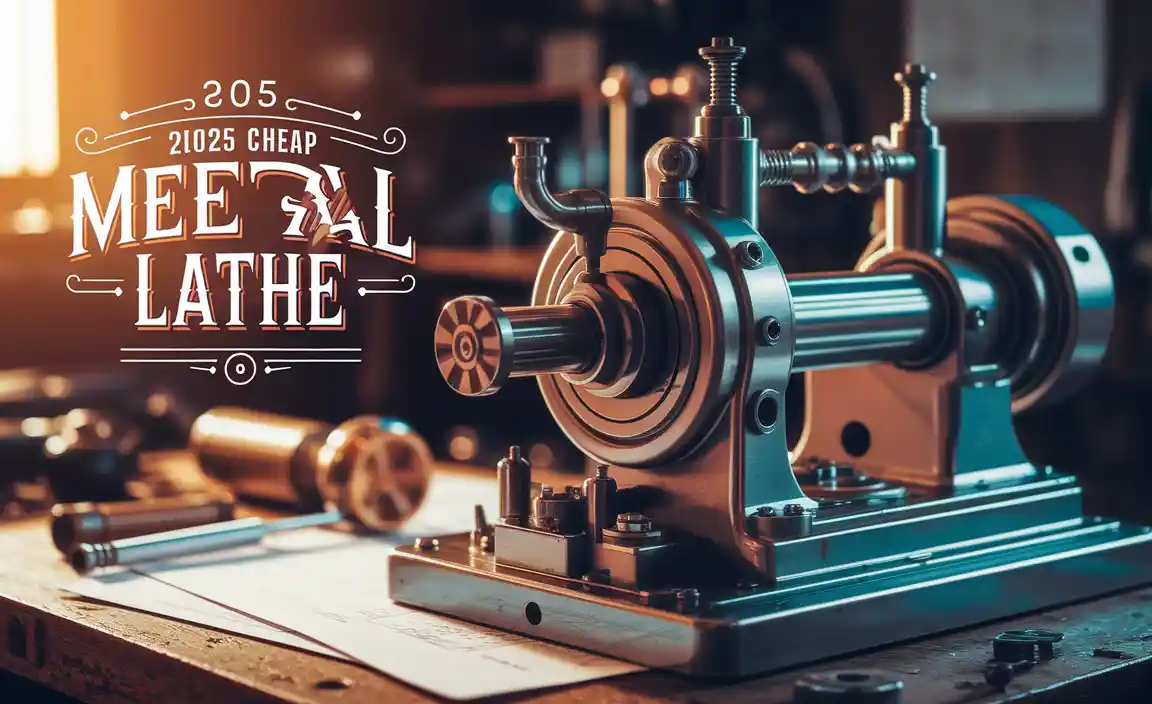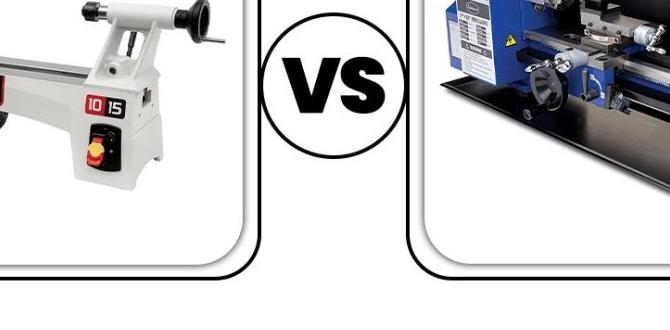Quick Summary: A lathe grinding attachment enhances precision by allowing you to grind hardened steel, sharpen tools, and create precise finishes directly on your lathe. Proper setup, wheel selection, and safety are key for successful, accurate grinding.
Ever looked at a perfectly smooth, precisely shaped metal part and wondered how it was achieved? Often, the magic happens on a lathe, but sometimes, standard lathe tools just can’t get the job done, especially with harder materials. This is where the humble yet mighty grinding attachment for your lathe comes in. It’s your key to unlocking finer finishes, sharper edges, and the ability to work with materials that would otherwise be impossible. Don’t let the thought of adding another attachment intimidate you; we’re here to break it down, step-by-step, making it simple and safe.
Getting started with a grinding attachment might seem a bit daunting at first. You might be thinking about wheel choices, mounting it just right, or even just how to turn it on safely. That’s perfectly normal! Here at Lathe Hub, we believe in demystifying machining. We’ll walk you through everything you need to know, from choosing the right attachment to making those perfectly ground surfaces. Let’s get your lathe ready for some serious precision work!
What is a Grinding Attachment for a Lathe?
Simply put, a grinding attachment for a lathe is a special tool that mounts onto your lathe to allow you to perform grinding operations. Instead of taking your workpiece to a separate grinding machine, you can bring the grinding function directly to your lathe. These attachments typically include a motor to spin a grinding wheel at high speeds. They are incredibly versatile and can be used for a variety of tasks, from sharpening tools to creating highly accurate finished diameters.
Think of it as an extension of your lathe’s capabilities. It’s designed to add a whole new dimension to what you can achieve with your machine. Whether you’re working with metal or even certain types of hard plastics, this attachment opens up possibilities for precision that are hard to match with conventional turning or milling.
Why Use a Grinding Attachment on Your Lathe?
You might be asking, “Why bother with a grinding attachment when I have other tools?” The answer lies in precision, versatility, and efficiency. Grinding is a finishing process that removes very small amounts of material, resulting in exceptionally smooth surfaces and very tight tolerances. Here are some key reasons:
- Achieve High Precision: Grinding can produce finishes and dimensions far more accurate than turning alone. This is crucial for parts that need extremely close fits.
- Work with Hard Materials: Many hardened steels and exotic alloys are too hard to be cut effectively with standard lathe tools. A grinding attachment can easily shape and finish these materials.
- Sharpen Tools: Keep your lathe tools, drill bits, and other workshop cutting tools razor-sharp for optimal performance and extended tool life.
- Create Specific Profiles: You can grind intricate shapes, chamfers, and radii with great accuracy.
- Improve Surface Finish: Grinding generates incredibly smooth surfaces, reducing friction and wear on mating parts.
- Save Time and Space: Instead of moving your workpiece to a dedicated grinder, you can perform the operation right on your lathe, saving setup time and workshop space.
Types of Grinding Attachments for Lathes
Grinding attachments come in a few main varieties, each suited for different needs. Understanding these will help you choose the right one for your workshop.
External Grinders
These are the most common type. They typically consist of a motor and a spindle that holds a grinding wheel. The entire unit is mounted to the lathe’s tool post, much like a regular cutting tool. This allows you to grind the outside diameter of your workpiece.
Internal Grinders
Less common for home workshops but essential for certain tasks, internal grinding attachments are designed to grind the inside diameter of holes. They usually feature a smaller, high-speed spindle that projects into the workpiece.
Tool Grinders
Some attachments are specifically designed for sharpening lathe tools, milling cutters, and other small cutting tools. These often have adjustable tool rests and can accommodate various grinding wheel shapes.
Essential Tips for Using Your Grinding Attachment
Now that we know what a grinding attachment is and why you’d use one, let’s dive into the practical aspects. Using a grinding attachment safely and effectively requires attention to detail. Here are some essential tips:
1. Select the Right Grinding Wheel
This is perhaps the most critical step. The grinding wheel is your cutting tool, and choosing the wrong one can lead to poor results, wheel damage, or even safety hazards. Wheel selection depends on:
- Material Being Ground: Different wheels are designed for different materials. Aluminum oxide wheels are common for steel, while silicon carbide is good for softer metals and non-ferrous materials. Diamond wheels are used for extremely hard materials like carbide.
- Type of Operation: For heavy stock removal, you’ll need a coarser grit. For fine finishing, a finer grit is necessary.
- Wheel Hardness (Grade): A harder grade wheel is more durable but can load up faster. A softer grade wheel wears away more quickly, which can be beneficial for preventing loading on soft materials.
- Wheel Structure: A more open structure allows for better chip clearance, reducing the chance of the wheel “loading up” with workpiece material.
Always check the manufacturer’s recommendations for the best wheel-grit-grade combination for your specific task and material. You can often find helpful charts from grinding wheel manufacturers like Norton or 3M.
2. Proper Mounting and Alignment
A securely mounted and correctly aligned grinding attachment is vital for accuracy and safety. Follow the manufacturer’s instructions carefully:
- Tool Post Mounting: Ensure the attachment is clamped firmly to the tool post. It should be rigid and not wobble.
- Height Alignment: The center height of the grinding wheel spindle should match the center height of your lathe’s headstock and tailstock. This ensures you’re grinding at the center of the workpiece. Misalignment can lead to taper or an uneven finish.
- Angle of Approach: For external grinding, the attachment is usually positioned parallel to the ways of the lathe. For some specific tasks, angling the attachment might be necessary, but this typically requires advanced setup.
Take your time with this. Double-check all bolts and clamps. A loose attachment isn’t just inaccurate; it’s a serious safety risk.
3. Setting the Depth of Cut
Just like with turning, you don’t want to take too aggressive a cut when grinding. Grinding is a removal process, and trying to remove too much material at once can:
- Overload the grinding wheel and motor.
- Cause excessive heat buildup, potentially damaging the workpiece or the wheel.
- Lead to a poor finish.
- Cause chatter or vibration.
For most operations, light, incremental passes are best. A common practice is to set the depth of cut to just a few thousandths of an inch (e.g., 0.001″ to 0.003″ or 0.025mm to 0.075mm) per pass. For very hard materials or fine polishing, even lighter passes are recommended.
4. Maintain the Grinding Wheel
Grinding wheels need maintenance to perform optimally and safely.
- Dressing: Over time, the cutting surface of a grinding wheel can become clogged with removed material (loading) or glazed over (dull). Dressing is the process of using a dressing tool (like a diamond dresser) to clean, true, and re-expose the sharp abrasive grains on the wheel’s surface. This restores its cutting ability and ensures it remains round. Most attachments will require dressing periodically.
- Balancing: A grinding wheel that is out of balance will vibrate excessively, leading to poor finishes, premature wear on the wheel and spindle, and potential damage to the attachment. Some wheels and spindles can be balanced. Check your attachment’s manual for instructions.
- Inspection: Before each use, inspect your grinding wheel for cracks, chips, or excessive wear. Never use a damaged wheel.
Proper wheel maintenance is crucial for both the quality of your work and your safety. A cracked wheel spinning at high RPMs can disintegrate catastrophically.
5. Coolant and Lubrication
Grinding generates a significant amount of heat. Using a coolant is essential for several reasons:
- Reduce Heat: Coolant dissipates heat, preventing the workpiece from overheating and distorting, and also keeps the grinding wheel from loading up or burning.
- Flush Away Debris: It washes away metal chips and abrasive particles, keeping the wheel clean and improving the surface finish.
- Lubricate: It can provide some lubrication, reducing friction between the wheel and the workpiece.
For metal grinding, a water-based coolant or a soluble oil is typically used. Ensure your setup can handle a coolant stream safely and effectively. For some light grinding operations or specific materials, a mist coolant can be sufficient. Always check the OSHA guidelines on metalworking fluids for safe handling and disposal.
6. Spindle Speed Requirements
Grinding wheels need to spin at a specific surface speed (feet per minute or meters per minute) to cut effectively. The required speed depends on the type of abrasive, the material being ground, and the diameter of the wheel. Your grinding attachment’s motor and spindle are designed for a certain RPM range.
Crucially, never exceed the Maximum RPM rating of the grinding wheel. This rating is printed on the wheel itself and is a critical safety specification. Use a wheel rated for a speed equal to or greater than your attachment’s maximum operating speed.
The ideal spindle speed for your attachment is often dictated by the attachment’s motor rather than being variable to match wheel speed in the same way a lathe spindle is. However, if your attachment offers speed control, ensure it allows for adequate speeds for efficient grinding. Always refer to the grinding wheel manufacturer’s guidelines for recommended surface speeds.
7. Use Personal Protective Equipment (PPE)**
Safety first, always! Grinding operations produce sparks, dust, and the risk of flying debris. Never compromise on PPE.
- Safety Glasses or Face Shield: Essential to protect your eyes from sparks and chips. A full face shield offers more protection.
- Hearing Protection: Grinding can be loud. Wear earplugs or earmuffs.
- Gloves: Wear snug-fitting gloves to protect your hands, but be cautious around rotating machinery, as loose gloves can get caught.
- Dust Mask or Respirator: Especially important when grinding materials that produce fine dust or when a lot of dust is generated.
Additionally, ensure your machine guards are in place and that you keep your work area clean and free of clutter.
8. Workpiece Speed and Feed
When grinding the exterior of a rotating workpiece on the lathe, you’ll typically use a much slower spindle speed than you would for turning. This is because the grinding wheel is doing the cutting, and the workpiece speed influences the rate of material removal and the surface finish. You want a slow, steady rotation of the workpiece.
The “feed” of the grinding wheel against the workpiece is controlled by the movement of the lathe’s cross-slide or compound rest. You will typically move the cross-slide very gradually and steadily to advance the grinding wheel into the workpiece.
Typical Speeds and Feeds Table
These are general guidelines. Always start conservatively and adjust based on your specific setup and material.
| Operation | Workpiece Spindle Speed (RPM) | Depth of Cut (Inches / mm) | Cross-Slide Feed (per pass) |
|---|---|---|---|
| External Grinding – Roughing | 50 – 150 | 0.001″ – 0.002″ (0.025 – 0.050) | Slow, steady cross-slide advance |
| External Grinding – Finishing | 100 – 200 | 0.0005″ – 0.001″ (0.012 – 0.025) | Very slow, steady cross-slide advance |
| Sharpening Tools (e.g., lathe bits) | N/A (Tool held against wheel) | As needed, light passes | Manual steady pressure/movement |
Remember, the goal is a smooth, controlled removal of material. Listen to the sound of the grinding; a harsh screeching usually indicates a problem like too deep a cut, a dull wheel, or inadequate cooling.
9. Allow for Wheel Clearance
When setting up, ensure there’s enough clearance for the grinding wheel to pass over the workpiece without hitting any chuck jaws, centers, or other lathe fixtures. This seems obvious, but it’s easy to overlook in the initial setup. Rotate the spindle manually (with power off) to check for any potential collisions.
10. Post-Grinding Procedures
Once you’ve completed your grinding operation:
- Withdraw the Wheel: Carefully back the grinding wheel away from the workpiece before turning off the grinding attachment’s motor.
- Allow Spindle to Stop: Let the grinding motor and wheel come to a complete stop before disengaging the attachment or moving the workpiece significantly.
- Clean Up: Remove any residual grinding dust and coolant from your lathe and work area.
These steps help prevent accidental damage to the finished surface or the grinding wheel.
Troubleshooting Common Grinding Issues
Even with the best practices, you might encounter some hiccups. Here are a few common problems and how to solve them:
- Poor Surface Finish (Rough or Scratched):
- Wheel is dull or loaded. Try dressing the wheel.
- Wrong grit wheel for the material or desired finish.
- Depth of cut is too heavy. Take lighter passes.
- Wheel speed is too low or workpiece speed is too high.
- Workpiece or grinding attachment is vibrating. Check mounting and alignment.
- Excessive Heat/Burning:
- Depth of cut is too heavy.
- Insufficient coolant or coolant is not reaching the grinding zone.
- Wheel is dull.
- Workpiece speed is too low.
- Wheel Loading (Material Clogging Wheel):
- Using a wheel that is too fine or too hard for the material.
- Insufficient coolant.
- Depth of cut is too heavy.
- Wheel is dull.
- Excessive Vibration:
- Wheel is out of balance.
- Wheel is improperly mounted or not dressed true.
- Grinding attachment or tool post is loose.
- Workpiece is not securely held or is unbalanced.
Consulting your attachment’s manual and grinding wheel manufacturer’s guides is always a good idea when troubleshooting.
Maintaining Your Grinding Attachment
Routine maintenance will ensure your grinding attachment remains accurate and reliable for years to come. Beyond wheel care:
- Keep it Clean: Regularly clean dust and coolant residue from the motor, spindle, and housing.
- Lubrication: Check the manufacturer’s recommendations for any lubrication points on the motor or spindle bearings.
- Inspect the Power Cord and Plug: Ensure they are in good condition to prevent electrical hazards.
- Storage: Store the attachment in a clean, dry place when not in use, protected from dust and moisture.
For more detailed maintenance, refer to the specific manual for your grinding attachment model. Resources like the Machinery Safety website offer general guidance on safe machine operation and maintenance that can be applied here.
Conclusion
Adding a grinding attachment to your lathe setup is a significant step towards achieving professional-level precision and versatility in your workshop. By understanding the fundamentals of wheel selection, proper mounting, controlled material removal, and diligent safety practices, you can confidently tackle tasks that were once out of reach. Remember, it’s about taking light, consistent passes, maintaining your equipment, and always putting safety first. With these essential tips, you’re well on your way to unlocking the full potential of your lathe for grinding operations, creating smoother finishes, and working with a wider range of materials than ever before.
Frequently Asked Questions (FAQ)
Q1: What is the most important safety rule when using a lathe grinding attachment?
The most critical safety rule





